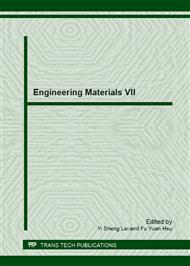p.19
p.31
p.37
p.43
p.49
p.61
p.69
p.77
p.87
Characteristics of Micro-Arc Treated Osseointegrated Porous Hydroxyapatite/Titanium Dioxide Coatings on Titanium Metal
Abstract:
A rapid and sufficient osseointegrating functions is obviously essential to the patients who suffered the bone reconstruction period. In order to perfectly target this issue, a single-stage micro-arc treated (MAT) coating beneficial from its inherent porous morphologies with controllable pore sizes, strong adhesive force between coatings and substrate and wide selections in electrolytes, is considered. Hydroxyapatite is extensively utilized and identified as mimic composition to human bone and an active bone ingrowth function. However, a controllable high-purity HAp phase via one-stage MAT has not yet been achieved. This study therefore prepares high-purity HAp coatings using one-stage MAT with the electrolyte combination of Calcium acetate and sodium biphosphate dihydrate on a titanium surface through a systematical evaluation of various MAT parameters, including Ca/P ratios of the electrolyte, electrolyte concentrations, working voltages, and treatment periods. Analytical results show that high-purity HAp can grow at a relatively high Ca/P ratio and electrolyte concentration when combined with a relatively high working voltage and long treatment time, which would otherwise grow with CaTiO3 and/or anatase TiO2 and/or rutile TiO2 simultaneously. Additionally, CaTiO3 acts a precursor phase for HAp formation. Ultimately, the highest purity of HAp coating is obtainable on metal titanium using a Ca/P ratio = 2.16 and applying a working voltage of 450 V for 10 min using one-stage MAT. This highest purity of HAp coating also presents excellent level of Ecorr than that on raw Ti alloys. The high Ecorr of HAp coating contributed from its thick and dense oxide layer by working voltage via one-stage MAT, consequently promises its satisfactory protection. The HAp coating demonstrated in this study not only provides the effective approach to produce the desired purity of HAp coatings but compromises its resistance to SBF. The bioactive HAp coating on Ti alloys via one-stage MAT, thus, considers as one significant surface modification for artificial hip joints and dental implants.
Info:
Periodical:
Pages:
49-59
Citation:
Online since:
September 2013
Authors:
Keywords:
Price:
Сopyright:
© 2014 Trans Tech Publications Ltd. All Rights Reserved
Share:
Citation:


